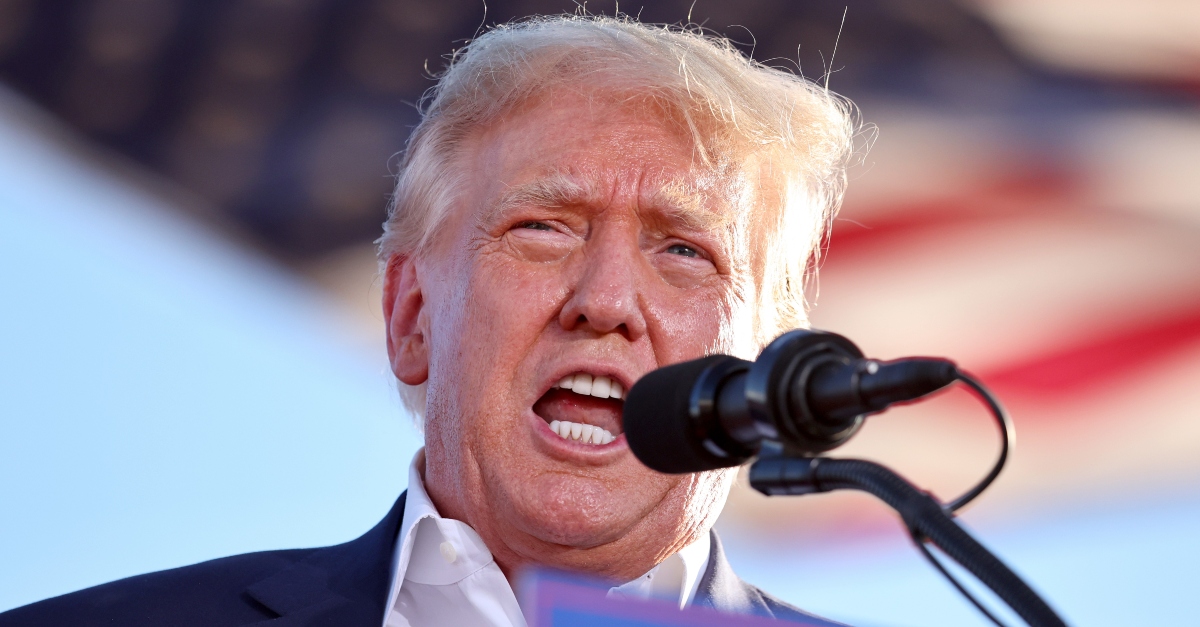
Donald Trump at October 09, 2022 rally.
ABA Legal Fact Check debuted in August 2017 and is the first fact check website focusing exclusively on legal matters. This article has been republished with permission.
Shortly after news broke that the FBI had raided former President Donald Trump’s Mar-a-Lago residence and seized boxes of classified documents, staunch ally Rep. Jim Jordan, R-Ohio, brushed off questions about the former president’s handling of top-secret documents. “He’s the ultimate classifier and decider,” Jordan said. “Everyone knows this is ridiculous.”
But more than two months after the Aug. 8, 2022, raid at Mar-a-Lago, the investigation continues amid conflicting interpretations of constitutional and federal and case law regarding the handling of classified information as well as the obligations of a chief executive to separate presidential and personal materials.
In an interview with Fox personality Sean Hannity, Trump defended his actions, saying: “There doesn’t have to be a process, as I understand it. … If you’re the president of the United States, you can declassify just by saying it’s declassified. Even by thinking about it.”
Most national security legal experts dismissed the former president’s suggestion that while in office he could declassify documents simply by thinking about it. But in theory, legal guidelines support his contention that a president has broad authority to formally declassify most documents that are not statutorily protected.
The system of classifying documents is largely a bureaucratic process used by the federal government to control how executive branch officials handle sensitive information, the release of which would cause harm, including possible damage to national security if exposed to the public. Unintentional violations are typically treated as noncriminal matters and are handled administratively through admonishment, loss of security clearances or employment termination. The government has criminally prosecuted serious mishandling of information, such as in the cases involving former national security adviser Sandy Berger and former CIA Director and retired Gen. David Petraeus, as well as cases involving deliberate leakers, such as Reality Winner and Edward Snowden.
The classification system is separate from criminal penalties that Congress has imposed to protect security secrets. For example, the Espionage Act of 1917 — one of the three laws cited in the search warrant of Mar-a-Lago in Florida — is designed to protect secrets related to defense information that could harm the U.S. or aid a foreign adversary. It makes no reference to materials’ classification status, and prosecutors in an Espionage Act case do not need to prove that materials were classified but rather that they were “closely held,” and their release could damage national security.
The search warrant executed in August at Mar-a-Lago cited as “probable cause” violations of relevant parts of the Presidential Records Act, which does not carry criminal penalties, as well as three provisions of criminal law: a part of the Espionage Act that deals with the mishandling of “national defense information” (18 U.S.C. § 793); a records-related obstruction statute (18 U.S.C. § 1519); and a third that deals with the mishandling of public records (18 U.S.C. § 2071). None of the three criminal statutes deal with classified material per se. Penalties differ. The obstruction-related statute carries the strongest sentence of a fine and a maximum 20 years in jail for each offense.
As an Aug. 4 Congressional Research Service (CRS) report described, procedures established in both the executive and legislative branches outline a process for declassifying intelligence, which includes deliberate methods for evaluating the need to serve the public interest while protecting intelligence. The classification system for national security information is principally a function of the president’s authority under the U.S. Constitution as commander in chief, which gives the president broad powers to classify and declassify such information.
Historically, both Republican and Democratic presidents have issued executive orders (EO), which spell out detailed sets of procedures, to implement this authority. In 2009, President Barack Obama issued EO 13526, the most recent EO which provided such guidance to federal agencies. But as a previous ABA Legal Fact Check noted, presidents can modify or nullify EOs although there is no evidence that then-President Trump did so with the Obama executive order.
Some secrets, such as information related to nuclear weapons, are handled separately under a specific statutory scheme that Congress has adopted under the Atomic Energy Act. Those secrets cannot be automatically declassified by the president alone and require, by law, extensive consultation with executive branch agencies.
In all cases, however, a formal procedure for recording and memorializing classification decisions is required so governmental agencies know with certainty what has been declassified. A federal appeals court in a 2020 Freedom of Information Act case, New York Times v. CIA, underscored that point in denying the paper access to documents after tweets by then-President Trump regarding a covert program in Syria. “Declassification cannot occur unless designated officials follow specified procedures,” the court said, citing Obama’s 2009 executive order in a footnote.
The closest recent example of a president brushing aside declassification channels was when George W. Bush, in his first term, authorized disclosure of parts of a classified National Intelligence Estimate to a reporter, effectively declassifying the material. The disclosure led to the 2007 conviction of former vice presidential aide I. Lewis “Scooter” Libby for obstruction of justice, lying under oath and making false statements. But Libby was not charged with disclosing classified information, leaving the legality of Bush’s declassification untested.
The scope of the documents taken by investigators from Mar-a-Lago is not publicly known, nor have any charges been filed. The Constitution, executive orders and case law clearly give the president broad authority to classify and declassify documents. Similarly, prevailing law also requires federal officials to follow certain procedures in declassifying documents to establish specificity and memorialization for future handling. But the extent of a president’s legal authority to unilaterally declassify materials — without those formalities — has yet to be challenged in court.
Read more of ABA’s Legal Fact Check series here.
[Image via Mario Tama/Getty Images]